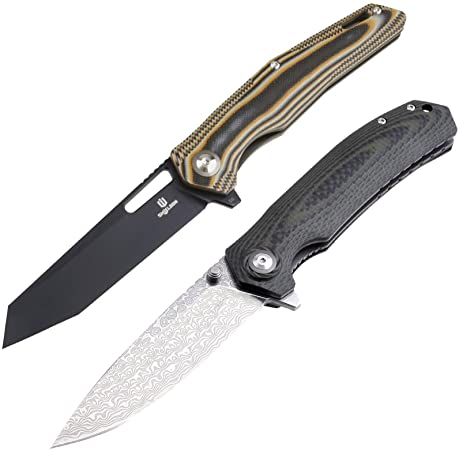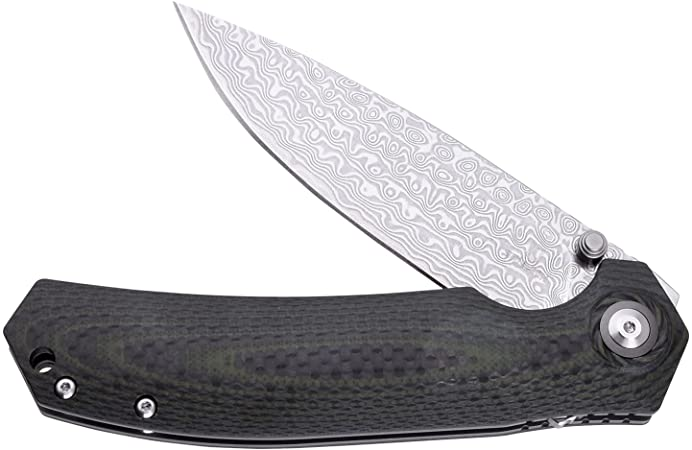For everyday carry knives and blades in general, size, style, practicality, deployment, and materials are all important. Because most steel blades are homogeneous in their silver-tone, they don’t have a big impact on the aesthetic of a knife. With Damascus steel, however, this is not the case.
The wavy flowing patterns of this unique material are well-known. And, because aesthetics aren’t everything, its startling good looks also serve to highlight the meticulous production process and the ensuing strength and longevity. This article will cover everything there is to know about Damascus steel and how it functions in folding knives.
What Is Damascus Steel?
This is a well-known form of steel that is distinguished by its watery or wavy light and dark pattern. It is also referred to as damasked steel. Damascus steel is one of the most well-known pre-industrial steel, and it’s commonly used in weapon blades. Aside from its beauty, Damascus steel is prized for its ability to keep a sharp edge while remaining firm and flexible.
Why The Name Damascus?
Damascus steel’s name remains a mystery. However, there are three prominent possible explanations for this. The first implies that steel was produced in Damascus. Another one relates to Damascus steel that has been purchased or traded. Last but not least, it relates to the steel pattern’s resemblance to damask cloth.
Weapons made of Damascus steel outperform weapons made of iron by a huge margin! Despite the fact that modern high-carbon steels created utilizing the 19th century Bessemer process outperform Damascus steel in terms of quality, the original metal remains an exceptional material, especially for its time.
Manufacturing Of Damascus Steel
Its manufacturing procedure comprised a secret carburization process in which a type of wrought iron was heated to red heat in confined vessels while in contact with various carbonaceous elements. As a result, an iron-carbon alloy with up to 1.8 percent carbon was created. It’s likely that the carburized metal was then annealed to remove some of the carbon before being pounded into bars and eventually fashioned into swords.
Damascus steel is known for its extreme hardness and a wet, streaked appearance generated by the original material’s fluctuating carbon levels. Occasionally, a single bar is welded together from multiple types of steel. The bar is doubled over, welded, redoubled, and rewelded until the layers of steel are entangled, then worked out to produce the blade. After quenching and polishing, the patterns that emerge are distinct and complicated.
Damascus blades are primarily appraised by their wetness, which serves as an indicator of the steel’s quality. It’s worth noting that modern Damascus steel isn’t identical to the original metal. Despite the fact that it was made using the same techniques, the original Damascus steel was made from wootz steel.
The History Of Damascus Steel
A Dresden scientist’s recent research into the structure and composition of true Damascus steel revealed that the steel’s almost mythical sharpness and strength were due to carbon nanotubes and carbide nanowires present in the forged metal’s structure. The origins of the name “Damascus” are still a source of debate.
Although it seems evident that the term alludes to Damascus-forged swords, there are various more possibilities. One is the Arabic term damas, which refers to a surface pattern of moire ripples that resembles turbulent water and may be found in various damask fabric weaves.
The original Damascus steel swords could have been manufactured anywhere from 900 AD to 1750 AD in the Damascus area of Syria. Damascus steel is a type of steel alloy that is both durable and flexible, which makes it perfect for sword construction. When Europeans first saw Damascus-made swords during the Crusades, they were supposed to have an almost mythological reputation. A Damascus steel blade was supposed to be capable of chopping through conventional blades, as well as rock, without losing its keen edge.
Recent metallurgical research based on microscopic studies of preserved Damascus-steel blades has claimed to be able to recreate very similar steel through probable historical process reconstructions. Impurities are added to a batch of steel to regulate the qualities of the final alloy.
During the Damascus steel era, up to 2% carbon could be added to make a hard and brittle alloy, or roughly 0.5 percent carbon could be added to make a soft and pliable alloy. For a swordsmith, the difficulty is that the best steel must be both hard and malleable. Once sharpened it should be difficult to keep an edge, yet pliable enough that it won’t break when slamming against other metals. With conventional processes, this was not possible.
Metalsmiths in India and Sri Lanka created a new method known as wootz steel, which produced high-carbon steel with extraordinarily high purity, possibly as early as 300 BC. Glass was heated after being added to a mixture of iron and charcoal. When the combination cooled, the glass would function as a flux, binding to other impurities in the mixture and allowing them to rise to the surface, leaving more pure steel.
Around July 1996, tens of thousands of steel-making sites were discovered in the Samanalawewa district of Sri Lanka, all of which produced high-carbon steel. Wind turbulence and suction were employed to generate heat in these steel-making furnaces, which were built facing western monsoon winds.
Carbon dating technology was used to date steel-making sites in Sri Lanka back to 300 BC. The technology spread slowly around the globe, arriving in modern-day Turkmenistan and Uzbekistan around 900 AD, and then in the Middle East around 1000 AD. This procedure was perfected in the Middle East, either by reworking wootz obtained from India or by employing locally made steel.
The specific process is unknown, but it allowed carbides to precipitate out of the blade’s body as microparticles grouped in sheets or bands. The precipitated carbides are significantly tougher than the surrounding low carbon steel, allowing the swordsmith to create an edge that could cut hard materials while the softer steel bands allowed the sword to function as a whole.
In 1981 two Stanford metallurgists sought a superplastic metal, according to The New York Times. They came up with a recipe that comprised a high concentration of carbon, which is one of the main components of steel, as well as a similar overall makeup to surviving Damascus blades. Damascus is still made today by fusing multiple types of steel together and folding them into layers. The final product will have varying properties depending on the steel used in the blend. The procedure is vigorous and detailed.
When Did Folding Knives Start Using Damascus Steel
Folding knives made of Damascus steel have a long and illustrious history. They were created around 2000 years ago and have a long history. For hundreds of years, they were known as “old steel,” and they controlled the armaments industry. Damascus steel made its first appearance in history during the Christian crusades in the 11th and 12th centuries.
Damascus steel gained popularity during these fights. You would think this knife came from Damascus, but it’s actually Telangana, Wootz, or Ukku steel from India. It eventually made its home in Damascus, Syria, where it was given the name Damascus.
Damascus steel blades have been made from a variety of steel kinds welded together to produce billets since 1973. Strips of iron are frequently included in these billets to provide the necessary molecular hardness. As a result, they are stretched out and stacked according to the needs indicated by the blade’s specific application as well as the blade owner’s preferences.
This suggests that Damascus steel blades are made on an individual basis rather than on an assembly line. Steel ingots are formed into billets, which are then folded like other metal types. The finished product can contain hundreds of layers and is guaranteed to have a solid density and varied design.
This structural phenomenon guarantees that the Damascus blade cuts smoothly and is long-lasting. The convex grind sharpens the thinness of the edge, allowing sliced material to give to the sides during the stroke and reducing “sticking,” which is common with blunt edges. As a result of the structural brittleness, the convex grind is required. Carbon nanotubes form in the steel at a deeper level, allowing for malleability and long-term strength throughout the forging process. The high carbon content ensures a decisive quality in steel integrity, ensuring great performance. This explains why carbon is so important in Damascus steel blade formation.
The process of making Damascus steel blades for your 접는 나이프 is straightforward, but it demands constant attention and precision. This is required to achieve the ideal aesthetics as well as the construction of a functional and well-balanced blade. In a crucible, you must gather the components.
Glass and leaves with antioxidant properties are among the ingredients. Then, using a hot crucible, combine the ingredients. Remove the metal ingots from the crucible once it has cooled to a temperature suitable for forging. While the metal is hot, carefully pound it. Reheat the metal to forge it once it has cooled. To sharpen edges and shape the blade, repeat this cycle as necessary.
Damascus steel folding knives are available in a variety of styles for a 다양한 용도, including camping, survival, wood-cutting, and hunting. The composites used to manufacture a Damascus knife must be tailored to the type of knife and the context in which it will be expected and/or used.
The advantage of any Damascus knife is that it is designed to withstand any force applied to it. It is both durable and powerful. They are less prone to rusting because they are made up of multiple layers of metal with various alloys. Additionally, its rough surface prevents food from sticking to it, allowing the knife to remain sharp for a longer period. Here are some of the most stunning Damascus blade folding knives available on the market.
SHIELDON Tanto Point D2 Blade
The blade on this knife is Material D2 with a Black Titanium finish. The flipper/hole system allows it to open smoothly and effortlessly. It’s an EDC knife with a beautifully crafted 67-layer genuine Damascus steel blade that’s been heat-treated to a hardness of 58-60 HRC, providing great functionality and longevity. The cutting edge of this knife is robust, sharp, and rust-resistant.
Both the flipper tag and the thumb stud readily deploy the blade thanks to the ball bearing in the pivot. The liner lock keeps the blade open and prevents it from closing unexpectedly. SHIELDON knives are designed with fashion and utility in mind, with an emphasis on design, quality, and function.
SHIELDON Damascus Pocket KnifeVG10 EDC
This knife is beautifully forged with a 67-layer genuine Damascus steel blade that has been heat-treated to a hardness of 58-60 HRC. With a robust, sharp, and rust-resistant cutting edge, all of this provides excellent functionality and lifespan. Both the flipper tag and the thumb stud readily deploy the blade thanks to the ball bearing in the pivot.
The liner lock keeps the blade open and prevents it from closing unexpectedly. Extreme comfort and excellent balance are provided by the beautiful blend of G10 and carbon fiber similar to shieldon folding pocket knife 9Cr18Mov. The handle is very attractive and well-designed ergonomically for efficient cutting. It is also very comfortable for a secure grip.
결론
Damascus steel and Damascus knives play an essential role in our lives, not only because of their history but also how they are crafted. Damascus knives are incredibly attractive and well-made. Every component and pattern is painstakingly crafted for a razor-sharp multi-functional blade that will last a lifetime. There is no such thing as having too many in your collection! Damascus steel has been associated with elegance and quality for ages, and a Damascus knife made today reflects this tradition.
At Shieldon, we offer the best pocket knives and 멀티 도구 that will meet your preference considering the quality. For high-quality Damascus knives, please feel free to 문의하기.








